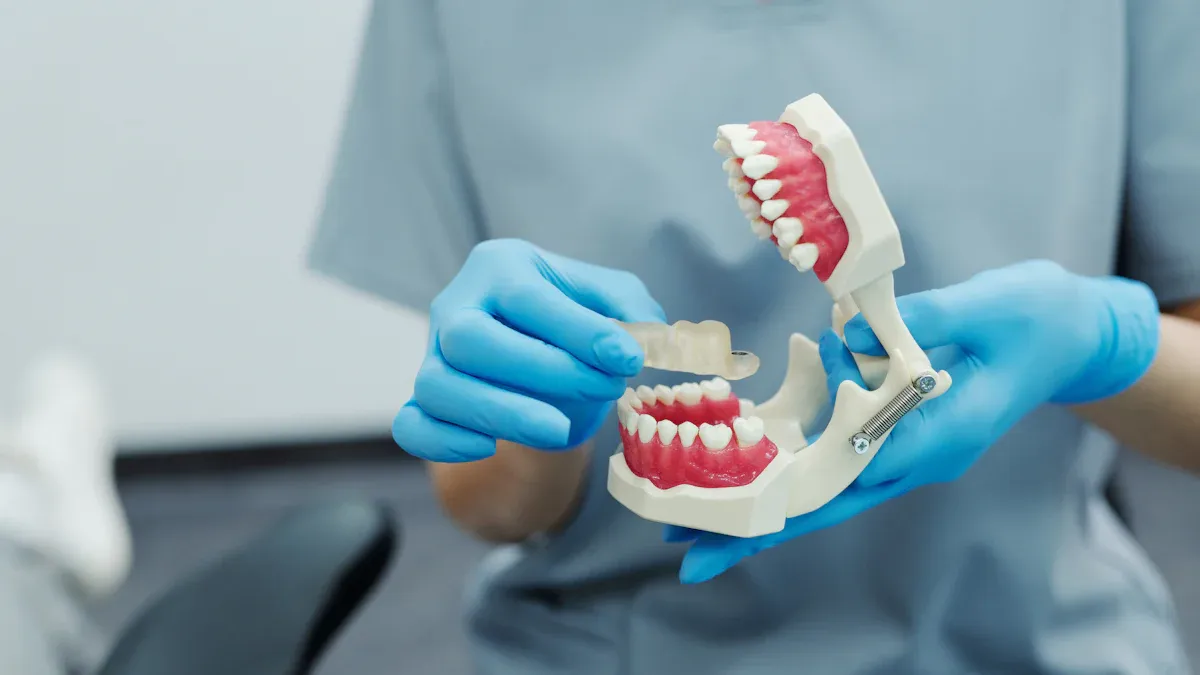Top Local SEO Tactics Dentists Need in 2025

If you want to attract more local patients in 2025, you need to focus on local SEO tactics that put your dental practice in front of the right people. Nearly three out of four patients now use online search to find a new dentist before booking, and most will reach out to a dentist they find online. Your online presence matters more than ever. Local SEO for dentists helps you stand out and stay ahead of other dentists in your area. When you use the right local SEO tactics, you make it easier for patients to discover your dental practice and choose you over the competition. As you read, think about how strong your local SEO is at the moment.
Did you know? Local SEO improves your visibility, boosts reviews, and helps your dental practice show up when patients search for a dentist nearby.
Why Local SEO Matters
Patient Search Trends
You might wonder how patients find a dentist in 2025. Most people now use their phones or smart devices to search for dental services. They often say things like, “Find a dentist near me,” using voice assistants such as Google Home or Alexa. Patients also check online reviews on platforms like Google Reviews, Yelp, and Healthgrades before making a choice. If your dental practice has a strong online presence, you will stand out to local patients.
Here are some of the most common ways patients search for dental services today:
- Voice search with conversational, local questions.
- Reading online reviews and checking your reputation.
- Using mobile-friendly websites that load fast and make booking easy.
- Engaging with dental practices on social media through stories and testimonials.
- Looking for remote care options like telemedicine, online chat, or two-way texting.
After the pandemic, more patients want convenience. They look for online appointment booking, digital forms, and even teledentistry. Many patients now expect you to offer these features. If you meet these needs, you will attract more local patients and keep them coming back.
Practice Growth
Local SEO helps dentists grow their practices by making sure you show up when local patients search for a dentist. When you optimize your Google Business Profile and use the right keywords, you increase your visibility in local search results. This means more people will find your dental practice and reach out for appointments.
Let’s look at how local SEO can boost your dental practice growth:
| Metric | Typical Improvement Range |
|---|---|
| Organic Traffic | 70-150% increase |
| New Patient Inquiries | 30-60% increase |
| Website Conversion Rate | 10-25% improvement |
| Local Search Visibility | 40-80% increase |
You can see real results by focusing on dental practice SEO. Dentists who use local SEO strategies—like building local links, managing reviews, and creating location-based content—see more website visits and new patient leads. Tracking your progress with tools like Google Analytics helps you keep improving. When you invest in local SEO, you help your dental practice grow and stay ahead of other dentists in your area.
Local SEO Tactics for Dentists
If you want your dental practice to stand out in 2025, you need to use a mix of local SEO tactics. These steps help you show up when patients search for a dentist nearby. Let’s look at the most effective ways to boost your local search optimization and attract more dental patients online.
Google Business Profile
Your Google Business Profile is the first thing many patients see when they search for dentists in your area. You should claim and verify your profile, then fill out every detail. Add your business name, address, phone number, hours, and services. Upload high-quality photos of your office and staff. Patients trust what they see, so clear pictures and virtual tours help them feel comfortable before they visit. Keep your profile updated with posts about new services or special offers. Respond to questions and reviews to show you care about patient satisfaction. When you keep your profile active and accurate, you increase your chances of showing up in Google Maps and the local pack.
Online Reviews
Online reviews are a big part of your reputation. Most patients read reviews before picking a dentist. You should ask happy patients to leave reviews on Google, Yelp, and other platforms. Respond to every review, both good and bad, to show you value feedback. A steady flow of positive reviews helps you rank higher in local search results. Reviews with keywords about your services and location can boost your dental SEO strategy. Remember, reviews are often the first impression new patients get of your dental practice.
Tip: Use AI-powered tools to help collect and respond to reviews quickly. This keeps your reputation strong and saves you time.
Local Keywords
Using the right local keywords helps you reach patients searching for dental care in your area. Add phrases like “best dentist in [Your City]” or “emergency dental care near me” to your website, service pages, and Google Business Profile. Focus on long-tail keywords that match what patients actually type or say. For example, “gentle dentist for kids in [Your City]” targets parents looking for a child-friendly office. Update your keywords often to match new trends and keep your content fresh. This is one of the best local SEO tips for staying ahead of other dentists.
Citations & Directories
Local citations and directories are online listings of your dental practice. You need to make sure your name, address, and phone number (NAP) are the same everywhere. List your practice on major sites like Google, Yelp, Healthgrades, and local business directories. Check your listings often to fix mistakes or remove duplicates. Consistent citations help search engines trust your information, which boosts your local SEO. For multi-location practices, create a separate listing for each office with unique details. This makes it easier for patients to find the right location.
Local Content
Local content connects your dental practice to your community. Write blog posts about dental tips, local events, or new services. Share stories about your team or highlight patient testimonials (with permission). Sponsor or join community events and post about them on your website and social media. This shows you care about your neighbors and helps you appear in more local searches. Local content also gives you a chance to use location-based keywords, making your site more relevant to people nearby.
Mobile & Voice Search
Most dental patients online use their phones to search for a dentist. Your website must be mobile-friendly and load quickly. Make sure buttons are easy to tap and forms are simple to fill out. Many patients now use voice search, asking questions like, “Where is the closest dentist?” Use natural, conversational phrases in your content and add a FAQ section to answer common questions. This helps your site show up when people use voice assistants. Fast, mobile-ready sites with clear answers win more local patients.
Note: Over 60% of dental searches happen on mobile devices. If your site isn’t mobile-ready, you could lose new patients to other dentists.
You need a complete approach to local SEO. Start with the basics—Google Business Profile, reviews, and local keywords. Then build on that with citations, local content, and mobile and voice search optimization. If you have more than one office, focus on location-specific pages and listings. For single-location practices, keep your information consistent and your reputation strong. Choose the tactics that fit your dental practice best, and keep improving as you grow.
Optimizing Google Business Profile

A strong google business profile helps you show up when patients search for a dentist nearby. If you want to boost your local search optimization, you need to make your profile as complete and engaging as possible. Here’s how you can do it step by step.
Claim & Verify
First, claim your google business profile. This gives you control over your listing and lets you update important details. To verify, follow Google’s instructions—usually by phone, email, or postcard. Once you verify, you can manage your profile and make sure all the information is correct. Patients trust dentists who have verified profiles because it shows you are real and active in your community.
Tip: Claiming and verifying your profile is the first step to showing up in Google’s local 3-pack, which puts your practice at the top of local search results.
Complete Info
Fill out every section of your google business profile. Use your real business name, address, and phone number. Make sure these match what’s on your website and other directories. Add your website link so patients can learn more about your services. Choose the right categories, like “Dentist” or “Pediatric Dentist,” to help Google understand what you offer. List all your dental services, from cleanings to emergency care. Update your business hours, including special holiday hours, so patients know when you’re open. Add social media links and enable online booking if possible. The more complete your profile, the more likely you are to earn trust and attract new patients.
Here’s a quick checklist for your profile:
- Accurate name, address, and phone number (NAP)
- Website and social media links
- Up-to-date business hours
- Full list of dental services
- Relevant categories and attributes (like accessibility features)
Photos & Posts
Photos make your google business profile stand out. Upload high-quality pictures of your office, team, and even happy patients (with permission). Add videos to show your practice’s personality. Patients love seeing where they’ll go for care. Post updates about new services, special offers, or community events. Regular posts keep your profile active and show Google that your practice is thriving. When you add new photos and posts, you build trust and help your profile appear in more searches.
Patients often choose a dentist based on photos and reviews. Keep your profile fresh and friendly to make a great first impression.
Managing Online Reviews

Online reviews shape how new patients see your dental practice. When you manage your reviews well, you build a strong reputation and help your practice grow.
Get More Reviews
You want more patients to share their experiences. Most people will leave a review if you ask them. Here are some simple ways to get more reviews for your dental practice:
- Ask for feedback right after a positive appointment. Patients feel happy and are more likely to help.
- Send follow-up emails or texts with direct links to your review profiles. This makes it easy for patients to leave a review.
- Encourage patients to mention the service they received and your city. This helps your local SEO.
- Respond to existing reviews. When patients see you care, they want to share their thoughts too.
- Remind patients on social media to leave reviews. A quick post can bring in new feedback.
- Offer small thank-yous, like a raffle entry, but always follow the rules of each review platform.
Tip: Automated messages after appointments save you time and help you collect more reviews without extra effort.
Respond to Feedback
You should reply to every review, both good and bad. When you thank patients for positive reviews, you show that you value their feedback. If someone leaves a negative review, respond with care and offer a solution. This shows you want to make things right.
- Quick replies show you pay attention and care about patient concerns.
- Professional responses help keep your reputation strong and show you want to improve.
- When you handle negative feedback well, you can turn unhappy patients into loyal ones.
A strong reputation online helps you stand out from other dentists. Patients trust you more when they see you care about their experience. This trust keeps them coming back and encourages others to choose your practice.
Local SEO for Dentists: Keywords
Research Local Keywords
You want your dental practice to show up when people search online. To do this, you need to find the right words that patients use. Start by thinking about what someone in your city might type or say when looking for a dentist. These are your targeted local keywords. For example, someone might search for “teeth cleaning in Austin” or “emergency dentist near me.”
You can use free tools like Google Keyword Planner or Ubersuggest. These tools help you see which words are popular in your area. Write down a list of location-specific keywords that match your city, neighborhood, or even nearby landmarks. Ask your team what questions patients ask most. Sometimes, the best ideas come from real conversations in your office.
Tip: Check out your competitors’ websites. See what words they use on their homepages and service pages. This can give you new ideas for your own keyword list.
Use in Content
Now that you have your list, it’s time to use those keywords on your website. Place service-oriented keywords on your main pages, like “dental implants” or “teeth whitening.” Add your location-specific keywords to your homepage, contact page, and service descriptions.
Here’s a simple way to organize your keywords:
| Page Type | Where to Use Keywords |
|---|---|
| Homepage | City name, main dental services |
| Service Pages | Specific treatments, local phrases |
| Blog Posts | Questions patients ask, local events |
| Contact Page | Address, neighborhood, city |
Don’t stuff your pages with keywords. Use them in a natural way, like you’re talking to a patient. Write clear sentences that answer common questions. This helps search engines understand your site and makes it easier for patients to find you.
Building Citations
Building strong citations helps your dental practice show up in more local searches. When you get your business listed in the right places, you make it easier for patients to find you online. Let’s break down what you need to do.
NAP Consistency
NAP stands for Name, Address, and Phone number. You want these details to match everywhere your practice appears online. If your information is different on each site, search engines get confused. Patients might also get lost or call the wrong number.
Here’s how you can keep your NAP consistent:
- Use the same spelling and format for your business name.
- Double-check your address, including suite numbers and abbreviations.
- Make sure your phone number matches your main office line.
Tip: Create a simple spreadsheet to track your NAP on every site. This helps you spot mistakes fast.
When you keep your NAP details the same, you build trust with search engines. This can boost your rankings and help more patients find you.
Directory Listings
You want your dental practice listed on important local listings and directories. Start with big sites like Google, Yelp, and Healthgrades. Then look for dental-specific directories and local business groups. Each listing acts like a vote for your practice, showing search engines that you are a real, trusted business.
Here’s a quick checklist for directory listings:
- Claim your listing on each site.
- Fill out every detail, including your website and services.
- Add photos to make your listing stand out.
- Update your listings if you move or change your phone number.
Don’t forget about high-quality local backlinks. These come from other trusted websites in your area, like local news sites or community groups. They help boost your authority and make your practice more visible.
Note: Local citations and directories are not a one-time job. Check your listings every few months to keep your information fresh.
Local Content Creation
Creating local content helps you connect with people in your community. When you share stories and information that matter to your neighbors, you show that your dental practice cares about more than just teeth. You build trust and make it easier for new patients to find you online.
Service Pages
You want your website to speak directly to people in your area. One of the best ways to do this is by building location-specific service pages. These pages focus on the dental services you offer in each city or neighborhood you serve. For example, you might have a page for "teeth whitening in Downtown Dallas" or "emergency dental care in Lakeview." Each page should answer common questions and include details about your office in that location.
Tip: Add photos of your team and office on each service page. This helps patients feel welcome before they even visit.
Here’s a quick checklist for strong service pages:
- Use your city or neighborhood name in the title and headings.
- List the dental services you offer at that location.
- Share directions or parking tips.
- Include a call-to-action, like "Book an appointment today!"
Community Updates
Sharing community updates is a great way to boost your local content. You can write about local events, health fairs, or school visits. If your team volunteers or sponsors a charity, talk about it on your blog or social media. Patients love seeing dentists who care about the community.
You can also post about dental health tips that matter to your area. For example, if your city adds fluoride to the water, explain how it helps teeth. Use photos and stories from real events to make your updates more personal.
Patients remember dentists who support their community. Local content keeps your practice top-of-mind when someone needs care.
Mobile & Voice Optimization
Mobile-Friendly Site
Most people use their phones to search for a dentist. If your website does not look good on a phone, you could lose new patients. You want your site to load fast and look great on any screen. Try this: open your website on your phone. Can you read the text without zooming in? Do the buttons work? If not, you need to make some changes.
Here are a few tips to help you:
- Use large, easy-to-read fonts.
- Make sure buttons are big enough to tap.
- Keep forms short and simple.
- Add click-to-call buttons so patients can call you with one tap.
- Test your site on different devices.
Patients will leave if your site is slow or hard to use. A mobile-friendly site keeps them happy and helps you get more appointments.
You also want to optimize your website for local search. This means your site should show up when people nearby look for a dentist. Add your city and neighborhood to your pages. Make sure your address and phone number are easy to find.
Voice Search Tips
Voice search is growing fast. Many people now ask their phones or smart speakers to find a dentist. They use questions like, “Who is the best dentist near me?” or “Where can I get a teeth cleaning today?” You want your website to answer these questions.
Here’s how you can get ready for voice search:
- Write in a natural, friendly way.
- Add a FAQ page with common questions and answers.
- Use short sentences and simple words.
- Include phrases people might say out loud.
Tip: Think about what your patients ask you every day. Use those questions on your website.
A site that works well for voice search helps you reach more patients. You make it easy for them to find you, book an appointment, and get the care they need.
Tracking Local SEO Results
Analytics Setup
You want to know if your local SEO work is paying off. The best way to do this is by setting up the right tools. These tools help you see how people find your dental practice online and what they do once they get to your site.
Here are some tools you should use:
- Google Analytics: This tool tracks how many people visit your website, where they come from, and what pages they look at.
- Google Search Console: This shows how your site appears in search results and helps you fix any problems.
- SEO software like Moz, SEMrush, or Ahrefs: These tools track your keyword rankings and backlinks.
- Many of these tools give you easy-to-read graphs and charts. You can export reports to share with your team.
- They also work well with other tools you may use, like WordPress or your CRM.
- Privacy matters. These tools help you keep patient data safe with secure storage and user permissions.
Tip: Set up these tools as soon as possible. The sooner you start tracking, the sooner you can see what works.
Key Metrics
Once you have your tools ready, you need to know what to watch. The right numbers tell you if your local SEO is helping you get more patients.
Here are the key metrics to track:
- Keyword Rankings: Check where your practice shows up for important local search terms.
- Organic Traffic: Look at how many people visit your site from search engines.
- Click-through Rate (CTR): See how many people click your site after seeing it in search results.
- Conversion Rate: Track how many visitors book an appointment or contact you.
- Bounce Rate: Watch how many people leave after viewing just one page.
- Session Duration: Longer visits mean people like your content.
- Total Conversions: Count how many new patients reach out through your website.
You can use a simple table to keep track:
| Metric | What It Shows |
|---|---|
| Keyword Rankings | Your spot in local search results |
| Organic Traffic | Number of visitors from search |
| CTR | How often people click your listing |
| Conversion Rate | Visitors who become patients |
| Bounce Rate | Visitors who leave quickly |
| Session Duration | Time spent on your site |
| Total Conversions | Appointments or contacts made |
Keep an eye on these numbers each month. When you see growth, you know your local SEO is working. If something drops, you can fix it fast. This helps you keep your dental practice ahead of the competition.
You have the tools to boost your dental practice with local SEO. Focus on these essentials:
- Keep your Google Business Profile complete and updated.
- Use location-based keywords on your website.
- Make sure your business info matches everywhere online.
- Ask patients for reviews and respond to them.
Many dentists miss out by skipping these steps or letting their info get outdated. Local SEO needs regular attention because search trends and Google rules change fast. If you want faster results or feel stuck, a local SEO expert can help you see real growth in just a few months.
FAQ
How often should you update your Google Business Profile?
You should check your profile every month. Update your hours, photos, and services when things change. This helps you stay visible and keeps patients informed.
Tip: Set a calendar reminder so you never forget to review your profile!
What is the best way to ask patients for reviews?
Ask right after their appointment. A quick thank you and a simple request work best. You can also send a follow-up text or email with a direct link.
- Always make it easy for patients to leave feedback.
Do you need a separate service page for each location?
Yes, if you have more than one office. Create a unique page for each location. Use the city name and local details. This helps you show up in more local searches.
How can you tell if your local SEO is working?
Check your website traffic and new patient calls. Use Google Analytics to track visits and conversions. Watch your keyword rankings.
Note: If you see more appointments from online searches, your local SEO is on the right track!
See Also
Comprehensive SEO Strategies Every Plumber Should Know
Effective Tips To Improve Your Search Engine Ranking
How To Use SEO Writing Tools To Enhance Rankings
Winning SEO Content Distribution Tactics For Marketing Growth

